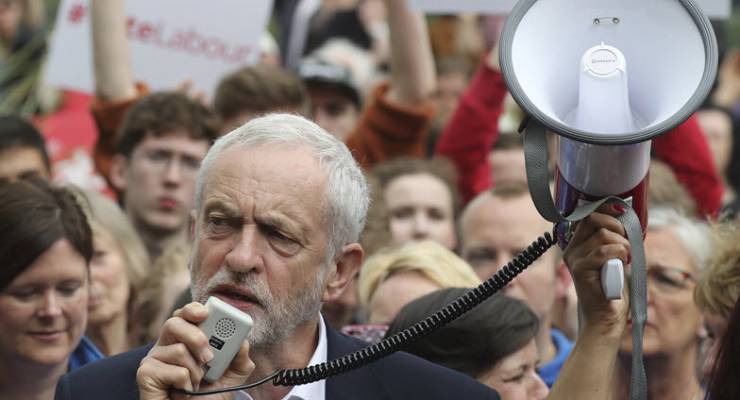
As the campaign enters its final week, the faintest glimmer is emerging that Britain’s general election could yet join Brexit and the election of Donald Trump as the latest jolt to political orthodoxy on either side of the Atlantic.
Labour’s meteoric rise in the polls was capped yesterday by a finding from YouGov that the Conservatives’ lead had dwindled to just three points — potentially sufficient to open the door to a “progressive alliance” government of Labour supported by the Scottish Nationalist Party and whatever might remain of the Liberal Democrats.
This is not to say that any more than a handful of Labour optimists consider such a result in any way likely, with Betfair continuing to offer the short price of $1.26 on a Conservative majority.
Nonetheless, the Labour surge has laid to rest the all-but-universal assumption that the party was headed for defeat on such a scale as to call into question its long-term viability — as well as dealing a body blow to the credibility and prestige of Prime Minister Theresa May, who called the snap election under the dubious pretext that her government needed a strong mandate as a basis to proceed with Brexit negotiations.
Remarkable as the changes in headline voting intention have been, a still more fascinating tale is being told by the pollsters’ age breakdowns.
According to the British Polling Council’s post-mortem into the polling industry’s disastrous performance at the previous general election in May 2015, the Conservatives under David Cameron owed their unexpectedly clear victory to a lead in the high teens among the over-50s (who will henceforth be referred to as “the old”), compared with a Labour lead of a shade over 10% among those under 35 (“the young”).
This state of affairs is familiar enough from recent form in Australia, where a modest Coalition victory would typically associate with a two-party advantage of 58-42 among the old, compared with a 55-45 lead to Labor among the young.
However, the situation in Britain had been transformed well before the present election campaign, with voters at opposite ends of the age spectrum taking entirely different views of Labour’s radical new look under Jeremy Corbyn.
Then came the still more polarising experience of the Brexit referendum last June, which by one account elicited a 75-25 split in favour of remain among those aged 18 to 24 who made the effort to vote, compared with 61-39 for leave among the greatly more active 65-plus cohort.
By the time Theresa May called the election in mid-April, polls were crediting the Conservatives with a crushing 56-19 lead among the old, while Labour continued to do about as well among the young as they had in 2015, with a lead of 38-29.
But this was only the beginning, as illustrated by the charts below, which respectively plot polling trends for young and old voters through the period of the campaign.
Labour’s eight-point gain among the old has been handy enough, albeit that it comes off a miserably low base. But it is put in the shade by the surge to Labour among the young, which has been in the order of 17%.
The end result is a perfect mirror image in which splits of 55-27 are recorded for both the young and the old, but with the advantage to Labour in the former case and the Conservatives in the latter.
As such, everything depends on the balance of turnout between the young and the old — and it’s on this basis that few expect Labour to win.
The conventional wisdom was acerbically expressed by an unidentified Conservative candidate who told the Huffington Post that “under 30s love Corbyn, but they don’t care enough to get off their lazy arses to vote for him”.
Certainly the historic record encourages this view, with a survey conducted after the 2015 election suggesting the young accounted for 29% of the adult population but only 22% of those who voted, compared with respective figures of 45% and 53% for the old.
However, it was exactly this sort of assumption based on past experience that led most observers so badly astray before the presidential election last November.
The Democrats in particular spent election day watching in horror as Hillary Clinton’s “basket of deplorables” — a designation applicable largely to culturally conservative working-class whites — descended on polling stations in unprecedented numbers to tear down the “firewall” that was expected to sustain her in the industrial states of the Midwest.
Labour’s hope, vague though it may be, is that the polls are detecting a similar surge not just in support but also in enthusiasm — in this case culminating in unprecedented turnout among the young that will up-end pollsters’ demographic models and provide the basis for yet another election night shock.









There is something stirring…..my 29 year old daughter, who did not vote in the Brexit poll, is very keen to get out and vote for Corbyn, who she won’t hear a word against. This has the look of a “movement”….but is it happening outside of London?
Fingers crossed! This does indeed seem like a crucial election for the interests of Britain’s young people, so let’s hope that motivates them to vote.
Do the disenfranchised young hate the present ‘establishment blues’ system enough?
I’d take a bit of that ‘4:1 Corbyn’ (TAB) – but I can’t get in….
Perhaps young voters are attracted to ‘old’ geezers nowadays eg: Bernie Sanders in the USA.
I’ve given up trying to figure out what inspires a young person to vote. My theory for the 2013 Oz election was that the youth vote would increase to guarantee support for the fast-speed NBN then being rolled out under Rudd. Rudd would ensure their Facebook interactions & internet trawling would operate at maximum speed. But no – the younger demographic didn’t flock to the polling booths & Abbott/Turnbull then screwed the NBN by reducing a desirable 100Mbps to 25Mbps.